

Jalandhara Bandha (Chin Lock) - Bandhas. Maha Bandha. Practice[edit] Precaution[edit] References[edit] External links[edit]
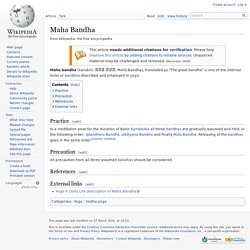
Using bandha to control energy from the breath. Two poles of a battery between which energy flows – in this way bandhas conduct breath through the body.
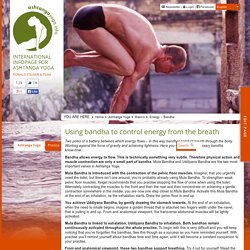
Working against the force of gravity and achieving lightness. Here you will find the necessary bandha know-how... Bandha allows energy to flow. This is technically something very subtle. Therefore physical action and muscle contraction are only a small part of bandha. Mula Bandha is introduced with the contraction of the pelvic floor muscles. You achieve Uddiyana Bandha, by gently drawing the stomach inwards.
Mula Bandha is linked to exhalation, Uddiyana Bandha to inhalation. From and anatomical viewpoint, these two bandhas support breathing. Lie completely relaxed on the floor, on your back. Bandhas for Beginners: Intro to Yoga's Interior Locks. Those of you that know me have heard about my first yoga class.

For those of you that do not (yet), I'll spare you the nitty gritty and just say this -- it was comical, and torturous. I arrived with basketball shorts down to my knees and old XL Stussy T-shirt. Models pranced painlessly on their mats while crunchies with closed eyes made lamaaz type sounds in the background. And the teacher went on and on and on about getting in touch with your sexual organs while harnessing your inner power and energy like the Hindu gods.
Half way through class I faked a cramp in order to escape with some ‘dignity.’ I went back to the teacher, and the studio, a week later, and within 3 months I was practicing every day, yes, still in my baller shorts and mega Ts. Jalandhara Bandha (Chin Lock) - Bandhas. Uddiyana Bandha, the Abdominal Lock. Jalandhara Bandha, the Throat Lock. Bandhas are energetic locks that contain the prana in the torso and concentrate it in the three main energy channels (nadis) of the body.

Jalandhara (upward pulling net) bandha can be performed in a physical and external manner engaging the skeletal muscles; it can also be felt as a subtle and internal energetic process. Jalandhara bandha engages and tones the neck muscles and also activates and energizes the 5th chakra center. Jalandhara bandha should be practiced individually at first, and then it can be incorporated with the other bandhas, asanas, pranayamas and eventually mudras. To practice Jalandhara Bandha, come into a comfortable siddhasana or sukhasana cross-legged seated position with the palms facing down on top of the knees. Let the spine be long, the shoulders relaxed down and the sternum lifted. Hold the abdominal lock for as long as comfortable, without strain. Jalandhara Bandha. Etymology[edit] Jālandhara bandha comes from Sanskrit.
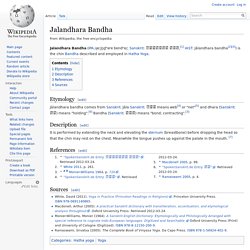
Jāla Sanskrit: जाल means web[4] or "net" and dhara (Sanskrit: धर) means "holding".[6] Bandha (Sanskrit: बंध) means "bond; contracting". Description[edit] Uddiyana Bandha. "Just as the bird soars into the sky, so does man score a victory over death, like a lion over an elephant, thanks to the vitality procured from uddiyana bandha.
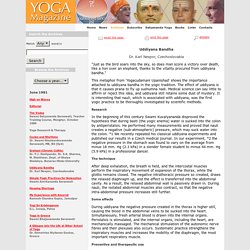
" This metaphor from 'Yogacudamani Upanishad' shows the importance attached to uddiyana bandha in the yogic tradition. The effect of uddiyana is that it causes prana to fly up sushumna nadi. Medical science can say little to affirm or reject this idea, and uddiyana still retains some dust of mystery.
It is interesting that nauli, which is associated with uddiyana, was the first yogic practice to be thoroughly investigated by scientific methods. Research. Uddiyana bandha. Uddiyana Bandha by Dr.
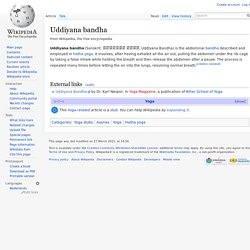
Karl Nespor, in Yoga Magazine, a publication of Bihar School of Yoga. Mula Bandha. Kevala Jñāna of Mahavira in mulabandhasana posture.

Mula bandha has its first literary mention in the oldest Jain canon Acaranga Sutra Mūla Bandha is a Sanskrit (मूल बंध) compound term: Mūla denotes "root", "base",[1] "beginning", "foundation",[2] "origin or cause", "basis", "source";[3] Bandha denotes "bondage", "fetter",[4] "posture",[2] "joining together", "catching hold of".[5] Iyengar (1976: p. 525) defines Mūla Bandha as: Bandha (Yoga) From Wikipedia, the free encyclopedia.
